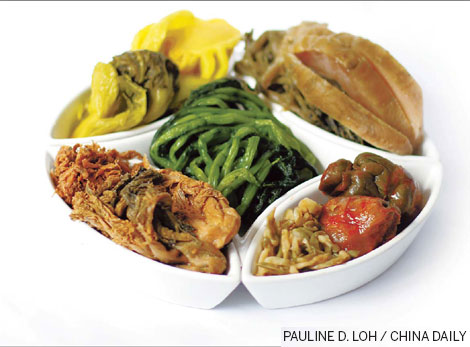Food
Preserving flavors
Updated: 2011-09-24 07:51
By Pauline D. Loh (China Daily)

You could write a book about pickled vegetables in China, but here are a few rudimentary lessons from Pauline D. Loh.
Asians have always treasured food. All vegetables, all meats are carefully preserved after harvests to last the year round. In China, even the humblest vegetables are carefully salted and pickled if there are excesses that cannot be eaten or sold immediately, and from these evolved a culinary tradition that has more than rewarded these thrifty habits with enrichment of the dinner table. It is a colorful platter of preserved vegetables. From the north, south, east and western provinces, different regions had their own ways of preserving mustard greens, radishes, turnips, garlic chives and cabbages.
Let's go through the more common and widely available preserved vegetables from China and look through their origins, history and culinary uses.
There is the famous Sichuan preserved vegetable or zha cai, popular as an instant side dish to noodles, congee or rice from Beijing to Shanghai to Chengdu. It is a relatively recent culinary "invention" with records showing that it was popularized only from 1890 onwards.
The mustard tuber, a member of the brassica family which includes cabbages, broccoli and kailan, was first cultivated in Sichuan. Later, the cultivation and production methods spread to Zhejiang, Fujian, Shanghai, Hunan, Guangxi and Taiwan.
In processing the preserved tuber, it had to be harvested, stripped of its leaves and the hard skin of the tuber trimmed. It is soaked in brine and then strung up to wind-dry.
One reason for the name - zha cai means "pressed vegetables" - is because the tubers are dehydrated by applying a heavy weight on them. The brining and dehydration process is repeated a couple of times.
The bigger tubers are then cut up, while the smaller tubers kept whole. The dehydrated tubers are then pickled in a mixture of spices, including salt, chili powder, prickly ash (Sichuan peppercorns), fennel, ginger, liquorice and Chinese herbs. The tubers are then placed in a large urn and more layers of salt and chili powder sprinkled on. The containers are then sealed, and kept cool for about three to four months. They are now sold whole, and cut up ready-to-eat in little packages.
Pickled potherb mustard or xuelihong has a very pretty name which means "red in the snow". This is a favorite Zhejiang-Shanghainese preserved vegetable, often stir-fried with broad beans, or the glutinous rice cakes that the Shanghainese love.
In Beijing, it is often cooked in a thick broth or in a cold dish, chopped and seasoned with just a dash of good sesame oil and chopped chili. It is also often stir-fried in lard, with just a smidgen of minced meat added for flavoring.
Potherb mustard is another member of the brassica/cruciferous family. (Cruciferous refers to the four-petalled, cross-shaped flowers that characterizes cabbages and mustards.)
Unlike the more robust members of the same family, the potherb mustard is a leafy vegetable - in other words, more herb-like, as its name suggests. It has a long growing season from spring to autumn and is harvested before it flowers so the whole vegetable is very tender. In the temperate regions of China, there is also a winter-growing version and xue cai is harvested several times a year.
Datou cai or the pickled kohlrabi is one humble preserved vegetable with a lot of history behind it. Its "inventor" is believed to be none other than China's most famous master strategist Zhuge Liang (AD 181234).
The story goes that Zhuge Liang was hibernating in-between battles at his mountain retreat in Wolong, in the Xiangfan region. He was in hermitage and lived by hunting and foraging with minimum contact with the outside world. He would gather mountain herbs and dig up wild kohlrabi and cut them up, lightly salting them as a simple accompaniment to his boiled rice or millet porridge.
One day, he was suddenly summoned to court and had to leave his meal half-eaten. When he returned a week later, the pot of rice had gone moldy, but the plate of salted kohlrabi looked even better and greener. He tasted it and was surprised to find that the vegetable had actually improved in taste.
There is no way to verify the truth of that story, but the Xiangfan region has been producing datou cai, pickled kohlrabi, for as long as we can remember.
And finally, there is the Tianjin pickled vegetable or dong cai, which is seldom eaten on its own. Instead, it is used as a seasoning for soups, added to stews, and mixed with meat for a taste that's all its own.
It is made from a simple Chinese cabbage and red-skinned leeks native to Tianjin, the coastal city slightly south of Beijing. Some special alchemy takes place during the pickling process and it develops its own unique fragrance and flavor.
Tianjin cabbage is already famous for its juicy sweetness, and the prefix "Tianjin" is assurance enough that it is a cabbage of the best pedigree. The other ingredients, the leeks and the best sea salt, are also famous Tianjin produce.
According to the records of one of the oldest producers of Tianjin dongcai (meaning winter vegetable), this product has been around since the last Han rulers of the Ming (1368-1644) dynasty. But it only reached the peak of its popularity at the end of the Qing dynasty (1644-1911), as China turned toward modernization at the turn of the 20th century.
Dongcai is made by cutting up squares of Tianjin cabbage, which is then laid out on mats to dry under the winter sun to naturally dehydrate. It is then brought indoors to start the fermentation process and seasoned with leeks and sea salt.
The leeks (part of the garlic family) have strong anti-fungal, anti-oxidant, anti-bacterial properties and are believed to cure rheumatism and other discomfort brought about by heat and humidity.
No wonder then, that the cooks of the southern coastal regions such as Guangzhou, Shantou and Fujian embraced this vegetarian seasoning with such enthusiasm.
E-paper

Pearl paradise
Dreams of a 'crazy' man turned out to be a real pearler for city
Literary beacon
Venice of china
Up to the mark
Specials

Power of profit
Western companies can learn from management practices of firms in emerging economies

Test of character
Keyboard-dependent Chinese are returning to school because they have forgotten how to write

Foreign-friendly skies
About a year ago, 48-year-old Roy Weinberg gave up his job with US Airways, moved to Shanghai and became a captain for China's Spring Airlines.
